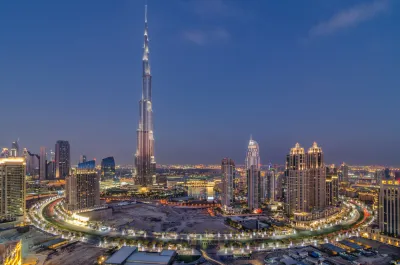A New York magazine article examines the idea of the mile-high skyscraper. Once imagined by Frank Lloyd Wright but impossible to build, the idea is not science fiction anymore.

Justin Davidson writes an in-depth article about the current limits of skyscraper technology and what it will take for the world's tallest towers to double in height and break the mile-high barrier.
Here Davidson introduces the idea of a mile-high skyscraper as impossible in the past and infeasible in the present:
"The mile-high skyscraper makes a little more sense to build now than it did when Frank Lloyd Wright designed one nearly 60 years ago. Wright imagined, on the fringes of Chicago, a habitable 528-story sundial called the Illinois. That idea wasn’t buildable then; its successor would still be risky, financially ruinous, slow to construct, and inefficient to operate. But that doesn’t mean a mile-high skyscraper won’t get done."
A common undercurrent of the article is an inherent warning: "A mile’s not science fiction. It’s not even an outer limit." But, writes Davidson, sometimes limits are a good thing: "Technological capacities have outpaced our judgment. We know we can do it, but we don’t know when not to do it."
The article includes technical detail about what makes the world's tallest buildings possible and some speculation about the challenges that the next generation of tallest towers will have to overcome in achieving new heights. Davidson also ties the conversation back to New York City—a place unlikely to ever have the "tallest anything" ever again but still not immune to the impacts of the skyward expansion of building technology.
FULL STORY: The Rise of the Mile-High Building

Analysis: Cybertruck Fatality Rate Far Exceeds That of Ford Pinto
The Tesla Cybertruck was recalled seven times last year.

National Parks Layoffs Will Cause Communities to Lose Billions
Thousands of essential park workers were laid off this week, just before the busy spring break season.

Retro-silient?: America’s First “Eco-burb,” The Woodlands Turns 50
A master-planned community north of Houston offers lessons on green infrastructure and resilient design, but falls short of its founder’s lofty affordability and walkability goals.

Test News Post 1
This is a summary

Analysis: Cybertruck Fatality Rate Far Exceeds That of Ford Pinto
The Tesla Cybertruck was recalled seven times last year.

Test News Headline 46
Test for the image on the front page.
Urban Design for Planners 1: Software Tools
This six-course series explores essential urban design concepts using open source software and equips planners with the tools they need to participate fully in the urban design process.
Planning for Universal Design
Learn the tools for implementing Universal Design in planning regulations.
EMC Planning Group, Inc.
Planetizen
Planetizen
Mpact (formerly Rail~Volution)
Great Falls Development Authority, Inc.
HUDs Office of Policy Development and Research
NYU Wagner Graduate School of Public Service

























